Preparation and Testing of Polyethylenimine-Impregnated Silica Gel for CO2 Capture
Abstract
1. Introduction
2. Materials and Methods
2.1. Preparation of the Sample
2.2. Analysis
2.2.1. BET Specific Surface Area and Pore Distribution
2.2.2. Elemental Analysis
2.2.3. Measurement of CO2 Adsorption Using Quantachrome AsiQ
2.2.4. TGA
2.2.5. SEM Analysis
3. Results and Discussion
4. Conclusions
Author Contributions
Funding
Institutional Review Board Statement
Informed Consent Statement
Data Availability Statement
Conflicts of Interest
References
- IPCC. Climate Change 2014 Mitigation of Climate Change; Cambridge University Press: Cambridge, UK; New York, NY, USA, 2015. [Google Scholar]
- Mikkelsen, M.; Jorgensen, M.; Krebs, F.C. The terraton challenge. A review of fixation and transformation of carbon dioxide. Energy Environ. Sci. 2010, 3, 43–81. [Google Scholar] [CrossRef]
- Liu, Q.; Kong, Y.; Sun, Z.; Liu, Z.; Shen, X. Facile synthesis of amine hybrid silica aerogel globule via wet casting assisted self-catalysed sol-gel process for CO2 capture including direct air capture. J. Environ. Chem. Eng. 2024, 12, 112913. [Google Scholar] [CrossRef]
- Hu, X.; Liu, L.; Xiao, G.; Shiko, E.; Zhang, R.; Fan, X.; Zhou, Y.; Liu, Y.; Zeng, Z.; Li, C.E. A review of N-functionalized solid adsorbents for post-combustion CO2 capture. Appl. Energy 2020, 260, 114244. [Google Scholar] [CrossRef]
- Shi, H.; Yang, J.; Ahmad, Z.; Zhang, H.; Chen, J. Co-grafting of polyethylenimine on mesocellular silica foam for highly efficiency CO2 capture. Sep. Purif. Technol. 2023, 325, 124608. [Google Scholar] [CrossRef]
- Das, S.K.; Wang, X.; Lai, Z. Facile synthesis of triazine-triphenylamine-based microporous covalent polymer adsorbent for flue gas CO2 capture. Microporous Mesoporous Mater. 2018, 25, 76–83. [Google Scholar] [CrossRef]
- Adeyemi, I.; Abu-Zahra, M.R.M.; Alnashef, I. Novel green solvents for CO2 capture. Energy Procedia 2017, 114, 2552–2560. [Google Scholar] [CrossRef]
- Rochelle, G.T. Amine Scrubbing for CO2 Capture. Science 2009, 325, 1652–1654. [Google Scholar] [CrossRef] [PubMed]
- Bonalumi, D.; Guiffrida, A. Investigations of an air-blown integrated gasification combined cycle fired with high-sulphur coal with post-combustion carbon capture by aqueous ammonia. Energy 2016, 117, 439–449. [Google Scholar] [CrossRef]
- Bonalumi, D.; Valenti, G.; Lillia, S.; Fosbøl, P.L.; Thomsen, K. A layout for the carbon capture with aqueous ammonia without salt precipitation. Energy Procedia 2016, 86, 134–143. [Google Scholar] [CrossRef]
- Kvamsdal, H.M.; Romano, M.C.; Ham, L.; Bonalumi, D.; Os, P.; Goetheer, E. Energetic evaluation of a power plant integrated with a piperazine-based CO2 capture process. Int. J. Greenh. Gas Control 2014, 28, 343–355. [Google Scholar] [CrossRef]
- Querejeta, N.; Plaza, M.G.; Rubiera, F.; Pevida, C.; Avery, T.; Tennisson, S.R. Carbon monoliths in adsorption—Based post-combustion CO2 capture. Energy Procedia 2017, 114, 2341–2352. [Google Scholar] [CrossRef]
- Dutcher, B.; Fan, M.; Russell, A.G. Amine-based CO2 capture technology development from the beginning of 2013—A review. ACS Appl. Mater. Interfaces 2015, 7, 2137–2148. [Google Scholar] [CrossRef] [PubMed]
- Jung, H.; Jeon, S.; Jo, D.H.; Huh, J.; Kim, S.H. Effect of crosslinking on the CO2 adsorption of polyethyleneimine impregnated sorbents. Chem. Eng. J. 2017, 307, 836–844. [Google Scholar] [CrossRef]
- Plaza, M.G.; González, A.S.; Pevida, C.; Rubiera, F. Influence of water vapour on CO2 adsorption using a biomass-based carbon. Ind. Eng. Chem. Res. 2014, 53, 15488–15499. [Google Scholar] [CrossRef]
- Plaza, M.G.; González, A.S.; Rubiera, F.; Pevida, C. Water vapour adsorption by a coffee-based microporous carbon: Effect on CO2 capture. J. Chem. Technol. Biotechnol. 2015, 90, 1592–1600. [Google Scholar] [CrossRef]
- Hosseini, A.A.; Lashaki, M.J. A comprehensive evaluation of amine-impregnated silica materials for direct air capture of carbon dioxide. Sep. Purif. Technol. 2023, 325, 124580. [Google Scholar] [CrossRef]
- Drage, T.C.; Arenillas, A.; Smith, K.M.; Pevida, C.; Piippo, S.; Snape, C.E. Preparation of carbon dioxide adsorbents from the chemical activation of urea–formaldehyde and melamine–formaldehyde resins. Fuel 2007, 86, 2204–2210. [Google Scholar] [CrossRef]
- Li, W.; Fu, D. Synergistic effect of surfactant and silica nanoflowers support on CO2 capture from simulated flue gas by solid amine adsorbents. Chem. Phys. Lett. 2024, 843, 141244. [Google Scholar] [CrossRef]
- Samanta, A. Post-Combustion CO2 Capture Using Solid Sorbents: A Review. Ind. Eng. Chem. Res. 2012, 51, 1438–1463. [Google Scholar] [CrossRef]
- Wu, X.F.; Yuan, B.; Bao, Z.; Deng, S. Adsorption of carbon dioxide, methane and nitrogen on an ultramicroporous copper metal-organic framework. J. Colloid Interf. Sci. 2014, 430, 78–84. [Google Scholar] [CrossRef]
- Chen, C.; Park, D.W.; Ahn, W.S. Surface modification of alow cost bentonite for post combustion CO2 capture. J. Appl. Surf. Sci. 2013, 283, 699–704. [Google Scholar] [CrossRef]
- Auta, M.; Hameed, B.H. Adsorption of carbon dioxide by diethanolamine activated alumina beads in a fixed bed. J. Chem. Eng. 2014, 253, 350–355. [Google Scholar] [CrossRef]
- Abd, A.A.; Naji, S.Z.; Hashim, A.S.; Othman, M.R. Carbon dioxide removal through physical adsorption using carbonaceous and non-carbonaceous adsorbents: A review. J. Environ. Chem. Eng. 2020, 8, 104142. [Google Scholar] [CrossRef]
- Guo, X.; Ding, L.; Kanamori, K.; Nakanishi, K.; Yang, H. Functionalization of hierarchically porous silica monoliths with polyethyleneimine (PEI) for CO2 adsorption. Microporous Mesoporous Mater. 2017, 245, 51–57. [Google Scholar] [CrossRef]
- Yu, C.H.; Huang, C.H.; Tan, C.S. A review of CO2 capture by absorption and adsorption. J. Aerosol Air Qual. Res. 2012, 12, 745–769. [Google Scholar] [CrossRef]
- Xu, X.; Andrésen, J.M.; Miller, B.G.; Scaroni, A.W. Preparation and characterization of novel CO2 “molecular basket” adsorbents based on polymer-modified mesoporous molecular sieve MCM-41. Microporous Mesoporous Mater. 2003, 62, 29–45. [Google Scholar] [CrossRef]
- Arenillas, A.; Smith, K.; Drage, T.C.; Snape, C.E. CO2 capture using some fly ash-derived carbon materials. Fuel 2005, 84, 2204–2210. [Google Scholar] [CrossRef]
- Ojeda, M.; Mazaj, M.; Garcia, S.; Xuan, J.; Maroto-Valer, M.M.; Logar, N.Z. Novel amine-impregnated mesostructured silica materials for CO2 capture. Energy Procedia 2017, 114, 2252–2258. [Google Scholar] [CrossRef]
- An, X.; Zhao, K.; Pang, W.; Zhang, W.; Wang, L.; Guo, T.; Fu, D. Balancing the CO2 adsorption properties and the regeneration energy consumption via the functional molecular engineering hierarchical pore-interface structure. Chem. Eng. J. 2022, 431, 133877. [Google Scholar] [CrossRef]
- Lin, L.; Han, S.; Meng, F.; Li, J.; Chen, K.; Hu, E.; Jiang, J. The influence of pore size and pore structure of silica-based material on the amine-modified adsorbent for CO2 capture. Sep. Purif. Technol. 2024, 340, 126735. [Google Scholar] [CrossRef]
- Kyselová, V.; Vysloužil, J.; Ciahotný, K. Preparation of impregnated material for separation of CO2. Paliva 2018, 10, 100–104. [Google Scholar] [CrossRef]
- Sakwa-Novak, M.A.; Yoo, C.; Tan, S.; Rashidi, F.; Jones, C. Poly(ethylenimine)-Functionalized Monolithic Alumina Honeycomb Adsorbents for CO2 Capture from Air. ChemSusChem 2016, 9, 1859–1868. [Google Scholar] [CrossRef] [PubMed]
- Jiao, J.; Cao, J.; Xia, Y.; Zhao, L. Improvement of adsorbent material for CO2 capture by amine functionalized mesoporous silica with worm-hole framework structure. Chem. Eng. J 2016, 306, 9–16. [Google Scholar] [CrossRef]
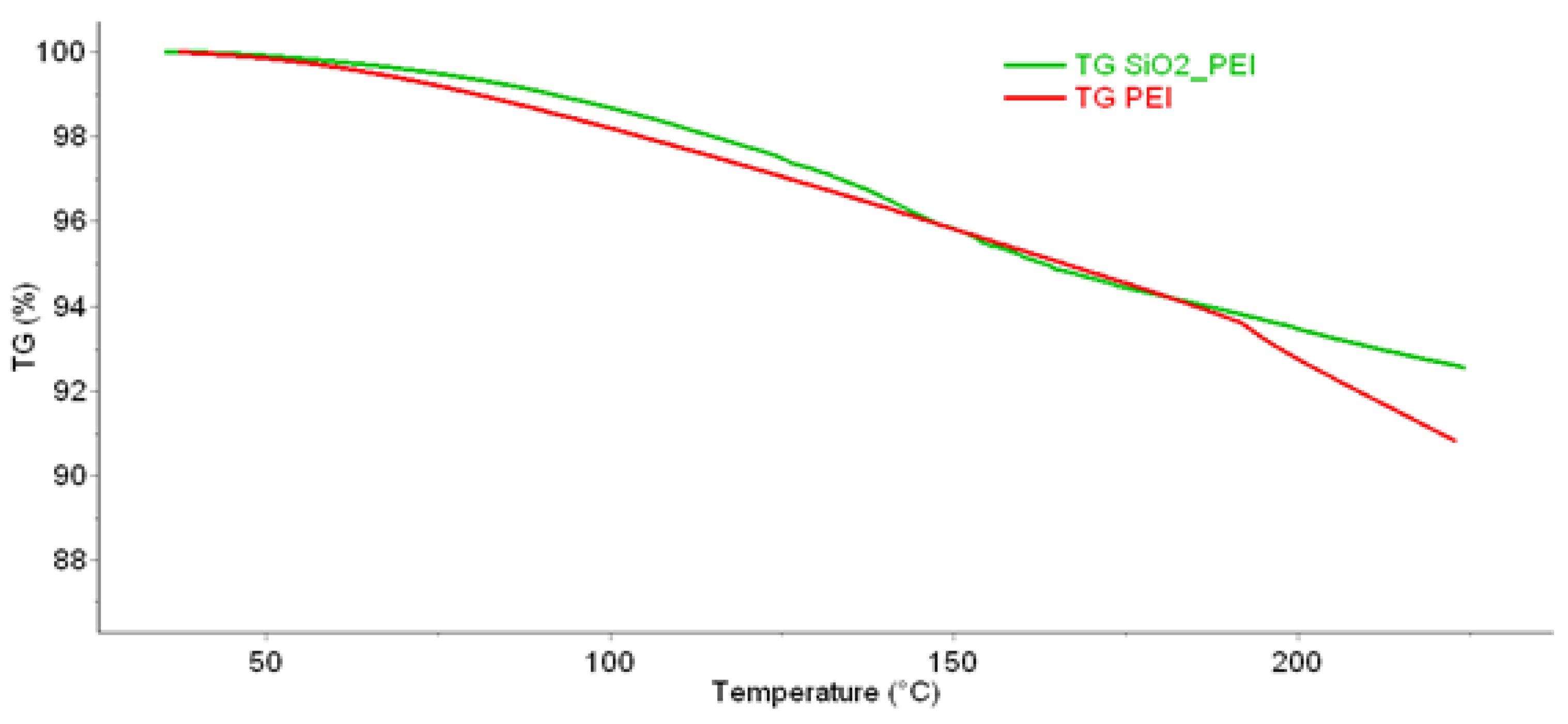
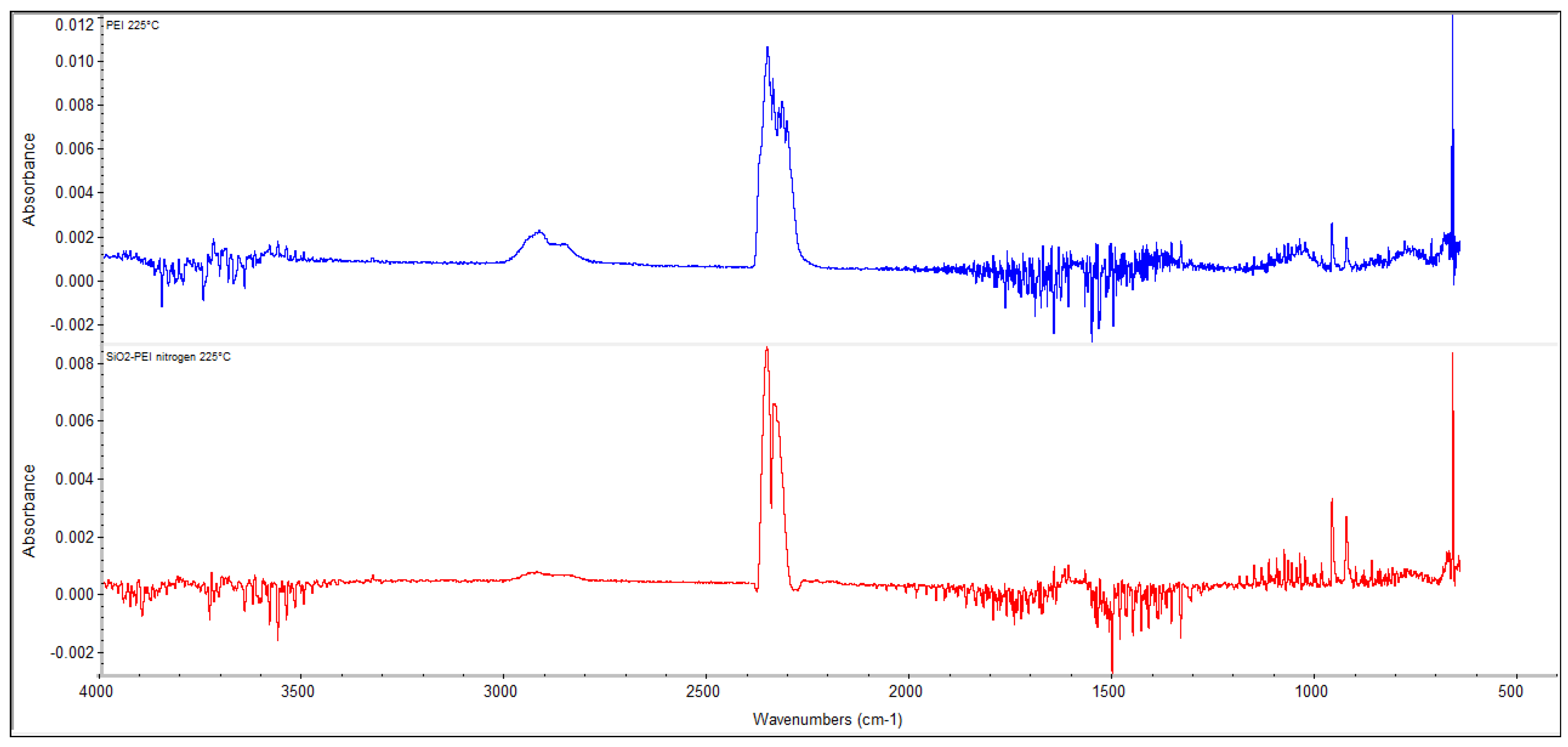

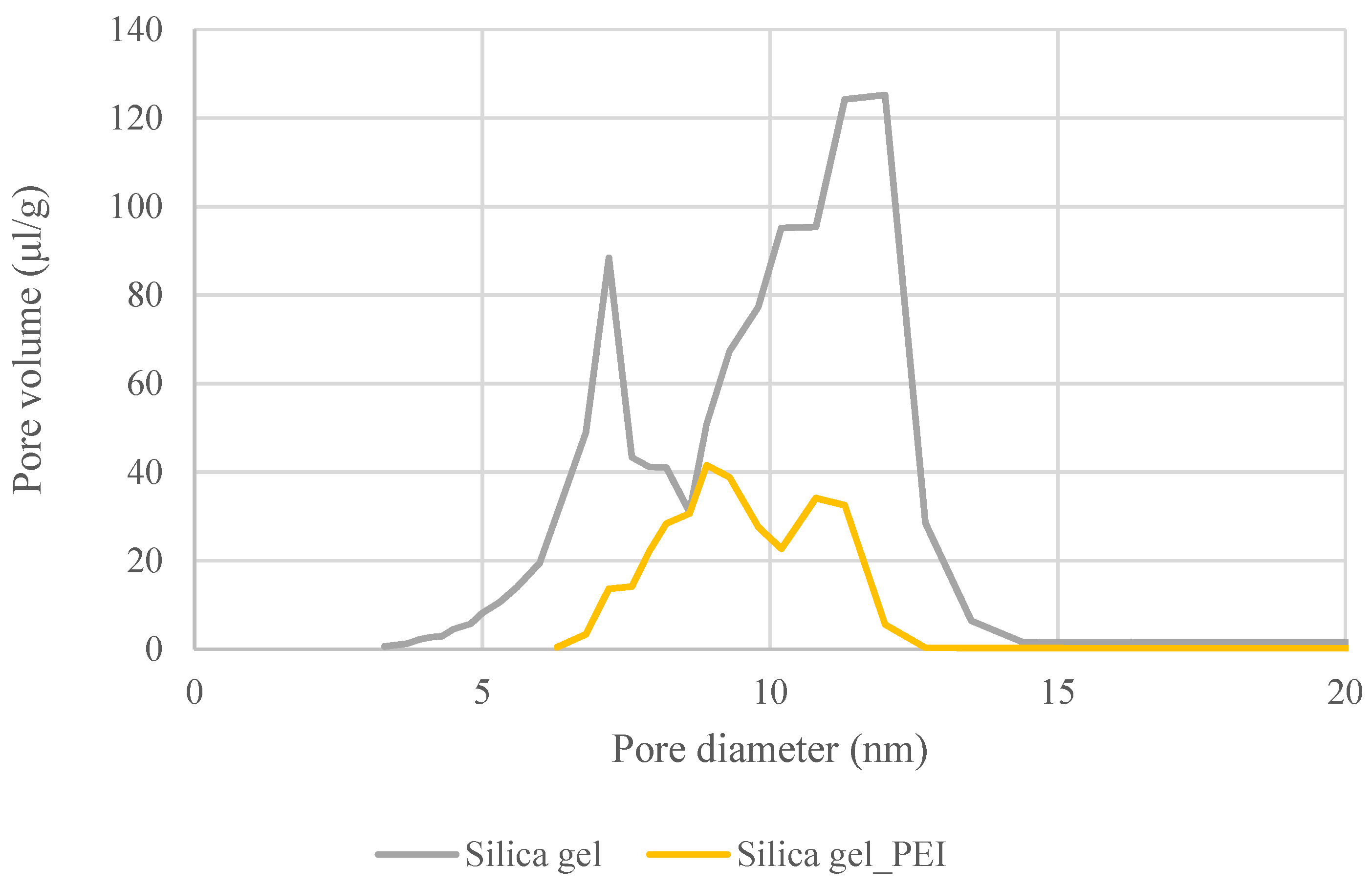
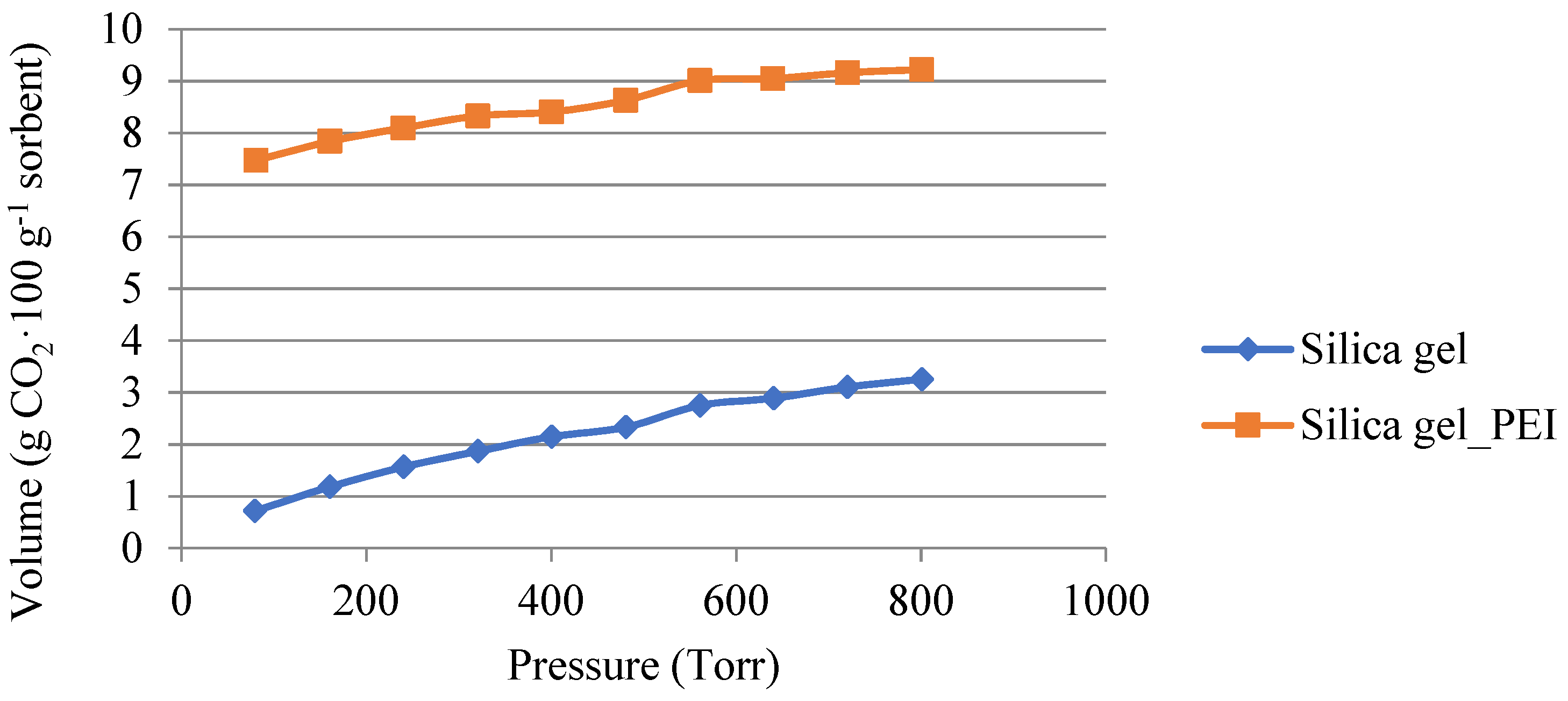
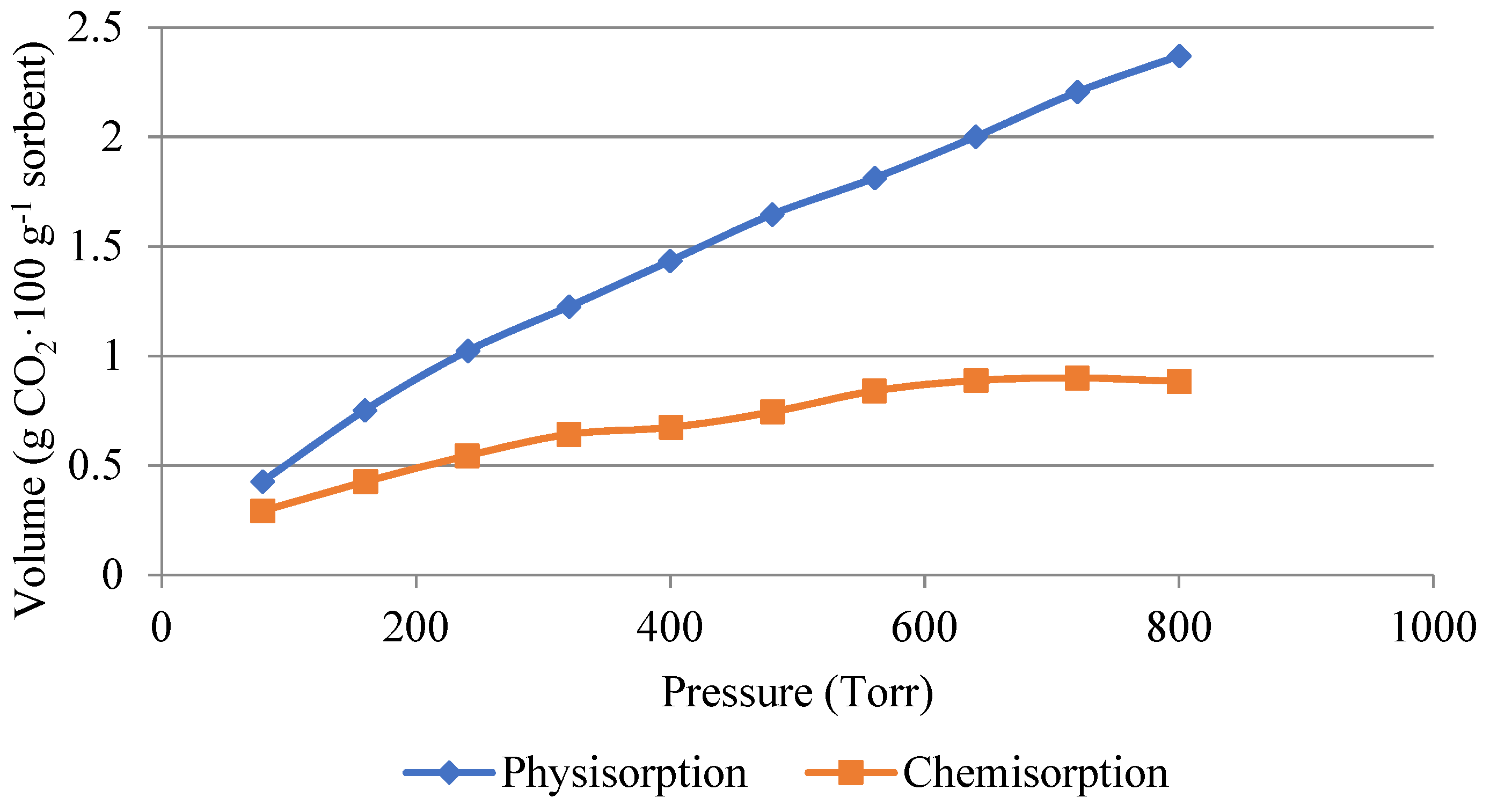

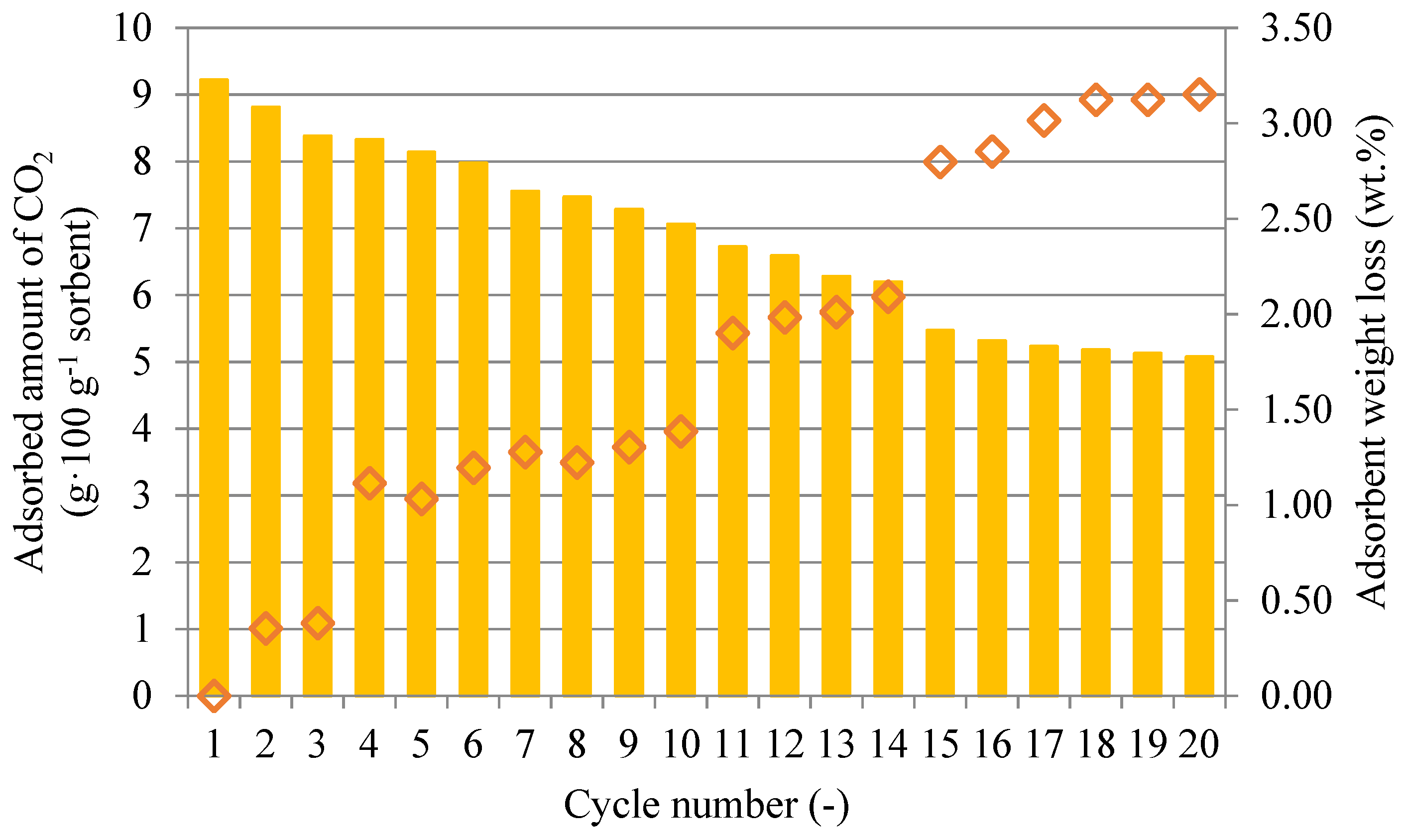

| Sample | N Content (wt.%) | C Content (wt.%) | H Content (wt.%) | PEI Content (wt.%) |
|---|---|---|---|---|
| Pure SiO2 | 0 | 0.22 | 0.72 | 0 |
| SiO2_PEI | 11.07 | 18.64 | 4.62 | 34.33 |
| Temperature (°C) | Adsorption Capacity (g/100 g Sorbent) | BET Specific Surface Area (m2·g−1) | Total Pore Volume (mL·g−1) |
|---|---|---|---|
| 30 | 7.44 | 396 | 0.988 |
| 50 | 3.26 | 396 | 0.984 |
| 80 | 2.80 | 396 | 0.997 |
| 100 | 0.68 | 397 | 0.979 |
| Temperature (°C) | Adsorption Capacity (g/100 g Sorbent) | BET Specific Surface Area (m2·g−1) | Total Pore Volume (mL·g−1) |
|---|---|---|---|
| 30 | 10.26 | 114 | 0.389 |
| 50 | 9.03 | 115 | 0.315 |
| 80 | 8.37 | 120 | 0.314 |
| 100 | 8.13 | 100 | 0.348 |
| Sample | N Content (wt.%) | C Content (wt.%) | H Content (wt.%) | BET Specific Surface Area (m2·g−1) | Total Pore Volume (mL·g−1) |
|---|---|---|---|---|---|
| SiO2_PEI before testing | 11.07 | 18.64 | 4.62 | 98 | 0.3030 |
| SiO2_PEI after 20 cycles | 8.59 | 16.26 | 3.20 | 151.44 | 0.2995 |
Disclaimer/Publisher’s Note: The statements, opinions and data contained in all publications are solely those of the individual author(s) and contributor(s) and not of MDPI and/or the editor(s). MDPI and/or the editor(s) disclaim responsibility for any injury to people or property resulting from any ideas, methods, instructions or products referred to in the content. |
© 2024 by the authors. Licensee MDPI, Basel, Switzerland. This article is an open access article distributed under the terms and conditions of the Creative Commons Attribution (CC BY) license (https://creativecommons.org/licenses/by/4.0/).
Share and Cite
Kyselová, V.; Havlín, J.; Ciahotný, K. Preparation and Testing of Polyethylenimine-Impregnated Silica Gel for CO2 Capture. Gels 2024, 10, 360. https://doi.org/10.3390/gels10060360
Kyselová V, Havlín J, Ciahotný K. Preparation and Testing of Polyethylenimine-Impregnated Silica Gel for CO2 Capture. Gels. 2024; 10(6):360. https://doi.org/10.3390/gels10060360
Chicago/Turabian StyleKyselová, Veronika, Jakub Havlín, and Karel Ciahotný. 2024. "Preparation and Testing of Polyethylenimine-Impregnated Silica Gel for CO2 Capture" Gels 10, no. 6: 360. https://doi.org/10.3390/gels10060360
APA StyleKyselová, V., Havlín, J., & Ciahotný, K. (2024). Preparation and Testing of Polyethylenimine-Impregnated Silica Gel for CO2 Capture. Gels, 10(6), 360. https://doi.org/10.3390/gels10060360








